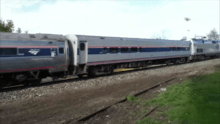Horizon (railcar)
| Horizon | |
|---|---|
 Amtrak Horizon car #54571 on a Lincoln Service in Springfield, Illinois in 2009. | |
.jpg) The interior of a coach on the Carl Sandburg in 2013. | |
| In service | 1989–present |
| Manufacturer | Bombardier Transportation |
| Family name | Comet (railcar) |
| Constructed | 1988–1990 |
| Number built |
104:
|
| Operator(s) |
Amtrak Caltrans |
| Depot(s) | Chicago, Los Angeles, Oakland |
| Line(s) served | Blue Water, Carl Sandburg, Hiawatha, Hoosier State, Illini, Illinois Zephyr, Lincoln Service, Missouri River Runner, Pacific Surfliner, San Joaquin, Saluki, Wolverine |
| Specifications | |
| Car length | 85 ft (25.91 m) |
| Width | 10 ft (3.05 m) |
| Height | 13 ft (3.96 m) |
| Doors | 2 manually operated dutch doors per side |
| Maximum speed | 125 miles per hour (201 km/h) |
| Power supply | 480 V AC 60 Hz Head end power |
| Bogies | GSI-G70 |
| Braking system(s) | Air |
| Coupling system | AAR |
| Track gauge | 4 ft 8 1⁄2 in (1,435 mm) |
| Notes | |
| [1] | |
The Horizon is a single-level model of rail car used by Amtrak, primarily on short-haul corridor routes in the Midwestern United States. Bombardier Transportation built 104 of the cars in 1988–1990 based on the Comet II commuter coach design.[2][3]
History
The design of the Horizon cars was adapted from the Comet, a single-level commuter coach originally designed and built by Pullman-Standard in 1970–1973 for the Erie Lackawanna Railroad. Bombardier acquired the rights to the design of the Comet car from Pullman and in 1982 built the second generation Comet II cars for New Jersey Transit.
In 1988, Amtrak and Bombardier signed a contract for 104 Horizon cars, a railcar based on the design of the Comet cars, but with some small modifications make them more suitable for inter-city rail service. They are designed with a maximum speed of 125 mph (201 km/h)[4] and rides on GSI-G70 outboard bearing trucks, also found on the Superliner II (which were also built later by Bombardier).[5]
The Horizon cars allowed Amtrak to add capacity to its fleet quickly, since it was adapted from a proven design that was already in full production. Amtrak was also able to privately finance the Horizon cars, making them the first railcars the railroad was able to purchase without securing federal funding.[6]
Bombardier delivered the cars between 1989 and spring 1990 in two basic types: 86 coaches and 18 food service cars.[7]
The 72 standard coaches could seat between 76 and 82 passengers depending on the seating configuration and 14 accessible coaches could 72 and included space for a wheelchair.[6] The entire coach fleet was later rebuilt to be accessible, with cars now seating between 68 and 72 passengers depending on the seating configuration.[7]
The 18 food service cars were configured in either a café/club (table seating on one end of the car and business class seating on the other) and dinette (all table seating) configurations.[8] Both configurations have a food service counter in the middle of the car.[6] The 8 cars in the café/club configuration could seat up to 32 people around dining tables and 19 people in business class seating. The 10 cars in the dinette configuration could seat up to 48 people around dining tables.[6]

The first Horizon cars entered revenue service in April 1989.[9]
In 1994, Amtrak considered ordering a further 23 Horizon cars to replace the troublesome gas-turbine Turboliner trainsets used on New York’s Empire Corridor service but budget woes prevented this.[10]:40–7
Routes served
As of November 2017, the Horizon coach cars primarily are used on trains based out of Amtrak's Chicago division including the Illinois Service (Carl Sandburg, Illini, Illinois Zephyr, Lincoln Service & Saluki), Michigan Services (Blue Water & Wolverine), Hiawatha, Hoosier State and Missouri River Runner.
Additionally, several Horizon cars are assigned to Amtrak's Los Angeles division for use on the Pacific Surfliner route.
The California Department of Transportation has also paid to lease and refurbish 3 dinette cars (all table seating) for use as café cars on the San Joaquin route where they are paired with refurbished Comet cars owned by the state.[11] These cars are assigned to Amtrak's Oakland division.
See also
- Shoreliner - Similar cars operated by Metro-North Railroad.
Notes
- ↑ Amtrak (May 2013). "Station Program and Planning Guidelines" (PDF). Archived from the original (PDF) on December 18, 2014. Retrieved November 29, 2014.
- ↑ Trainweb.org Amtrak roster page
- ↑ Horizon car numbers
- ↑ Amtrak 2015, p. 40
- ↑ Bing, Berry & Henderson 1996, p. 3-11
- 1 2 3 4 "Amtrak's Passenger Trains" (PDF). Amtrak. 1990. Retrieved 17 May 2015.
- 1 2 Simon & Warner 2011, p. 224
- ↑ Solomon 2004, pp. 132–133
- ↑ Stephenson, Dick (July 1989). "Amtrak/Passenger". Pacific RailNews (308): 13–14. Archived from the original on 2013-10-02.
- ↑ U. S. Industrial Outlook, 1994. DIANE Publishing. 1994.
- ↑ San Joaquin Joint Powers Authority/Caltrans. "San Joaquin Rolling Stock Presentation" (PDF). pp. 35–42. Retrieved 30 June 2013.
References
- Amtrak (October 27, 2015). "Capital Investment Plan for Amtrak Equipment Deployed in State Corridor Service FY2016 – FY2020" (PDF).
- Bing, Alan J.; Berry, Shaun R.; Henderson, Hal B. (1996). Design Data on Suspension Systems of Selected Rail Passenger Cars (PDF). Washington, D.C.: Federal Railroad Administration.
- Johnston, Bob (December 2001). "Amtrak responds, reacts...and hopes". Trains. 61 (12): 18–20. ISSN 0041-0934.
- Simon, Elbert; Warner, David C. (2011). Amtrak by the numbers: a comprehensive passenger car and motive power roster, 1971-2011. Kansas City, Missouri: White River Productions. ISBN 978-1-932804-12-6.
- Solomon, Brian (2004). Amtrak. Saint Paul, Minnesota: MBI. ISBN 978-0-7603-1765-5.
External links

- Amtrak Photo Archives- Horizon Fleet Cars